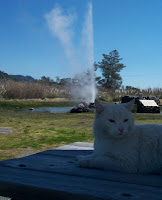One of our early day trips was to the Napa Valley. The Napa Valley is about an hour's drive from San Francisco and is renowned for its wines. We took this trip at the start of February because we wanted to ensure that we finished the stock before we left (well all except one bottle ... see the Playing Catchup Blogging post for further details - Tony). Unfortunately none of the wines was outstanding - I guess that's what happens when you choose your wineries from a backpacker's guide.
Napa Valley wineries
We were all "tasted out" by the time we reached the Robert Mondavi Winery. In any case, we had already tried many of their wines as they featured prominently on the wine list at the Courtyard Marriot in San Bruno, the hotel where Tony and I initially stayed.
Calistoga
At the northern end of the Napa Valley is Calistoga, a town famous for its mineral water and hot springs. It is said that the town's name was derived from the founder's description of the town as the "Calistoga of Sarafornia". He meant to say the "Saratoga of California", Saratoga being a well-known spa town in New York. (He'd obviously sampled one too many of the local reds - Tony)
We visited Calistoga to see the Old Faithful Geyser and the Petrified Forest.
Old Faithful Geyser
- A self-guided walk around the "grounds"
You can walk across the grounds in about 5 minutes. I'm sure the parking lot is bigger.
- A small video room showing old TV coverage of the Geyser
- Three fainting goats
We haven't worked out what fainting goats have to do with geysers yet.
- Information on how geysers form
- Picnic grounds
The pool was later used as a wishing well, and numerous coins remain, covered in mineral deposits. The triangular holes are presumably how the hot water entered the pool; we could see steam still rising up through them.
- The diner sold burgers - very important
- It was not far from the geyser
- We had to come back past the diner to go the Petrified Forest
- It was located on Mitzi Drive and we had to get a photo of the sign
(Funny, I recall a different ordering of these features ... - Tony)
So here is the photo complete with the requisite fire hydrant.
The Petrified Forest
This wood pile shows some petrified tree logs in their natural state. Most of the petrified trees displayed in the park are blasted with high-pressure water hoses to remove the lichen and dirt.
This cow sculpture was on display outside the Sonoma City Hall.












No comments:
Post a Comment
Comments for posts older than 14 days will not be immediately displayed. We review these comments before publishing them for public display.